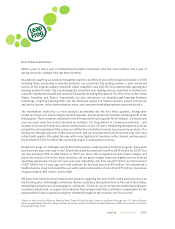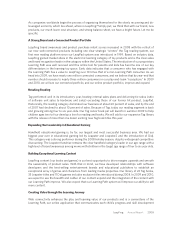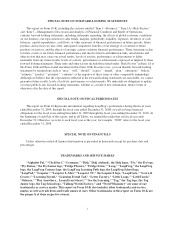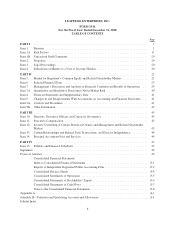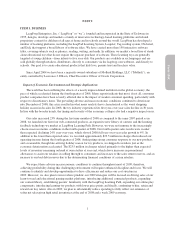LeapFrog 2008 Annual Report Download - page 13
Download and view the complete annual report
Please find page 13 of the 2008 LeapFrog annual report below. You can navigate through the pages in the report by either clicking on the pages listed below, or by using the keyword search tool below to find specific information within the annual report.
arrangements in countries such as Australia, Japan, Germany and Korea, among others. Our
International segment represented approximately 21%, 23% and 23% of our consolidated net sales in
2008, 2007 and 2006, respectively. No single country represented 10% or more of LeapFrog’s
consolidated net sales in any of the three years. In 2008, Toys “R” Us and Wal-Mart accounted for 10%
and 13%, respectively of our International segment’s gross sales. In 2007, no single customer accounted
for 10% or more of our International segment’s gross sales.
Product Portfolio
LeapFrog’s product portfolio for both of our business segments includes the following:
•Reading Solutions:
• Our Tag reading system, or Tag, introduced worldwide in 2008, is a pen-based reading system that
leverages the core technology of optical hardware and optical character reading software. The Tag
reading system focuses on fundamental reading skills and offers an extensive library of interactive
books based on both children’s classic book titles and popular licensed characters such as Dr. Seuss’
Cat in the Hat, Disney Princess, and Nickelodeon’s SpongeBob Squarepants.
• The LeapPad learning system, or LeapPad, was historically our most popular learn-to-read
product. It includes devices that introduce basic vocabulary and reading concepts for preschool and
kindergarten children through music, talking characters, engaging narration and interactive play, and
that can also be used to reinforce learning English as a second language. Tag was developed as a
next generation replacement for LeapPad.
•Educational Gaming and Grade School Products:
• We produce educational gaming products primarily for children ages four to twelve years old. Our
educational games embed learning skills into action-packed games often featuring well known
licensed content. The Leapster Educational Gaming system, Leapster, or classic Leapster, was
launched in 2003. The platform is a handheld device targeted at four to eight year olds, with a multi-
directional control pad and a touch-screen enabled by a built-in stylus. During 2008 we introduced
the Leapster2 platform, a web-connected version of our Leapster handheld, which connects to the
LeapFrog Learning Path. We also launched five Leapster software titles including “Star Wars: The
Clone Wars” and Disney’s “Wall-e.” Our library of over 40 Leapster software titles is compatible
with both Leapster and Leapster2.
• The Leapster L-MAX, a television compatible version of the Leapster platform, has been phasing
out in the United States and some international retail markets in 2008.
• We expanded our educational gaming line in 2008 with the introduction of the Didj Custom Gaming
System, or Didj. Didj is a web-connected handheld device that allows for customization of
curriculum and game play. Didj has higher resolution graphics and is also integrated with the
LeapFrog Learning Path. The Didj software library contains approximately ten titles, including
some popular licensed content, such as LucasArts’ “Clone Wars,” and “Hannah Montana” by
Disney.
• In October 2008, we introduced the Crammer Study and Sound System, or Crammer, a hybrid music
player and study device. Targeted at kids eight to twelve years old, the Crammer is an electronic
study device featuring custom flash cards, on-board games and free downloadable educational
content, all playable while listening to music.
•Learning Toys:
• Learning Toys are stand-alone products that help develop fine motor skills, color, and sound and
letter recognition for infants and children through age five. The products are generally more
affordable and simpler to localize for foreign markets than our platform and content suites.
3


